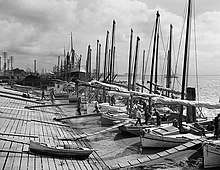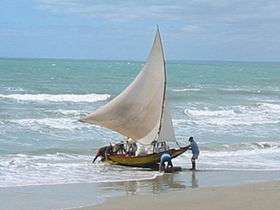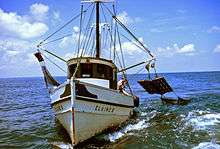Lugger
A lugger is a sailing vessel defined by its rig, using the lug sail on all of its one or several masts. They were widely used as working craft, particularly off the coasts of France, England, Ireland and Scotland. Luggers varied extensively in size and design. Many were undecked, open boats, some of which operated from beach landings (such as Hastings or Deal). Others were fully decked craft (typified by the Zulu and many other sailing drifters). Some larger examples might carry lug topsails.[1]

Luggers were used extensively for smuggling from the middle of the 18th century onwards; their fast hulls and powerful rigs regularly allowed them to outpace any Revenue vessel in service. The French three-masted luggers also served as privateers and in general trade. As smuggling declined about 1840, the mainmast of 3 masted luggers tended to be discarded, with larger sails being set on the fore and mizzen. This gave more clear space in which to work fishing nets.[2](pp15-19)
.jpg)
Local types
- British Isles
- Coble, used on the English east coast from Yorkshire to Northumberland
- Five Man boats, large 55-65 foot boats used for line fishing on the Yorkshire coast
- Cornish lugger
- Deal lugger, the 2 larger types of boat used by Deal boatmen to service ships anchored in the Downs. These were beach-launched open boats, originally 3 masted, but the main-mast was later dispensed with to allow more room, ultimately giving jib, dipping lug foresail and a standing lug mizzen sheeted to an outrigger. A first-class lugger or "fore-peaker" was typically 38 feet long, 12 ft 3 inches at greatest beam, carried 6 tons of ballast in a clinker-built hull weighing 3 and a half tons. They could carry a replacement anchor and cable out to a large ship - a load of at least 6 tons.[3]:113-147[4]:55–123
- Fifie, a herring drifter of the Scottish east coast
- Hastings lugger
- Manx nickey
- Manx nobbyCorentin, a replica chasse-marée
- Sgoth Niseach, dipping lug
- Continental Europe
- Barca-longa, of the Iberian and Mediterranean coasts
- Breton chasse-marée. These were fast-sailing cargo vessels that took fresh fish to market, sometimes taking general cargo for the return trip. They set standing lugs on three masts and a jib. Topsails were often used and topgallants when racing.
- French lugger (lougre), of the coast of Normandy
- United States of America
- New Orleans Lugger(also known as an Oyster Lugger). These shallow draft vessels were typically 37 ft overall with a 12 ft beam - (though could vary substantially in size). They set a dipping lug on a single mast and had a centre board to help go to windward in deeper waters. They were used principally for fishing, with some cargoes occasionally carried. They could be found from Texas to the West coast of Florida.[3]:358–363
 Oyster Luggers in New Orleans
Oyster Luggers in New Orleans
- Australia
- Some of the early pearling luggers used off the northern coast line of Australia from about the 1870s, often ship's boats, carried a lug sail, but the purpose-built boats that were used from the 1880s stopped using it over time. The majority of these were gaff-riged ketches, although they continued to be called pearling luggers until the present day.[5][6]
References
- Greenhill, Basil; Mannering, Julian, eds. (1997). The Chatham Directory of Inshore Craft: Traditional Working Vessels of the British Isles. London: Chatham Publishing. ISBN 1 86176 029 9.
- March, Edgar J. (1952). Sailing Drifters: The story of the herring lugger of England, Scotland and the Isle of Man (1969 reprint ed.). Newton Abbott: David and Charles (Publishers) Limited. ISBN 0 7153 4679 2.
- Leather, John (1979). Spritsails and Lugsails (1989 reissue ed.). Camden, Maine: International Marine Publishing Company. ISBN 0877429987.
- March, Edgar J. (1970). Inshore Craft of Great Britain in the Days of Sail and Oar. Volume 2 (2005 ed.). London: Chatham Publishing. ISBN 1 86176 269 0.
- "Pearling Luggers". Australian National Maritime Museum. Retrieved 11 April 2020.
- Collins, Ben (5 January 2019). "Lost luggers and the rough seas facing wooden boatbuilding". ABC News. Retrieved 11 April 2020.
See also
- Mystery, lugger
- Spirit of Mystery, replica of the lugger Mystery
- Sophie Theresia (herring lugger)
- Leopold Janikowski sailed in a lugger to Cameroon in 1882
Further reading
- Shearwood, Ken (1972) Evening Star: the story of a Cornish lugger. Truro: D. Bradford Barton
External links
| Look up lugger in Wiktionary, the free dictionary. |
- Cornish Luggers: an online guide
- Cornish Luggers: an online guide; Beer luggers (formerly in use on the south Devon and Dorset coasts)

